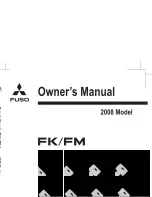
GENERAL INFORMATION 0-4
F ig . 4 —V e h ic le Liftin g Points - C h evy Van
however, with the rear wheels off the ground if there is
damage in the rear wheel area. In this event, the trans
mission selector lever should be placed in the “ N”
(neutral) position and the front drive disengaged. Towing
speeds should not exceed 35 MPH for distances up to
50 miles. If truck is towed on its front wheels, the
steering wheel should be secured to keep the front wheels
in a straight-ahead position.
When towing the vehicle at slow speeds (approx. 20
MPH), for a very short distance only, the transmission
must be in netural and the transfer case MUST be in
“ TWO WHEEL HIGH.”
When towing the vehicle at faster speeds for greater
distances, the following steps MUST be taken:
• If front wheels are on the road, disconnect the front
drive shaft.
« If rear wheels are on the road, disconnect the rear
drive shaft.
Both manual and automatic transmissions should be
towed in neutral only, with parking brakes fully released.
When towing a vehicle on its front wheels only, the
steering wheel should be secured to maintain a straight
forward position.
Push Starts—Trucks Equipped with
Automatic Transmission
Do not attempt to start the engine by pushing the truck.
Should the battery become discharged, it will be neces
sary to use an auxiliary battery with jumper cables to
start the engine.
CA U TIO N :
To prevent damage to electrical
system never connect booster batteries in ex
cess of 12 volts and connect positive to positive
and negative to negative.
Lifting Van With Hoist
Many dealer service facilities and service stations are
equipped with a type of automotive hoist which bears upon
some part of the front and rear axles in order to lift the
vehicle. In Figure 4 the shaded portions indicate areas
recommended for hoist contact.
Lifting With Auto Jack
The shaded areas on both the front and the rear axles,
as shown in Figure 4 are recommended Van jack lifting
points. The jack load rest must locate under the axle at
these points.
LOAD CAPACITY CHART
New spring capacities and mandatory equipment options
are included in the Load capacity chart on the following
pages.
CHEVROLET TRUCK SERVICE MANUAL
Summary of Contents for 10 Series 1968
Page 1: ...ST 1 3 3 SB...
Page 3: ...w w...
Page 52: ...HEATER AND AIR CONDITIONING 1A 21 Fig 32 Charging Schematic CHEVROLET TRUCK SERVICE MANUAL...
Page 67: ......
Page 128: ...BODY IB 61 Fig 135 A uxiliary Seat CHEVROLET TRUCK SERVICE MANUAL...
Page 132: ...Fig 4 1 0 3 0 Series Truck Frame...
Page 133: ...Fig 5 4 0 6 0 Single A xle Truck Frame E x c Tilt Cab...
Page 135: ...Fig 7 4 0 6 0 Series Tilt Cab Truck Frames...
Page 139: ...w...
Page 169: ...fit w...
Page 233: ...I...
Page 248: ...BRAKES 5 15 TD 50 60 Fig 26 Parking Brake Cables T Models CHEVROLET TRUCK SERVICE MANUAL...
Page 347: ......
Page 389: ......
Page 393: ......
Page 411: ...ENGINE FUEL 6M 18 Fig 18A V 8 Typical CHEVROLET TRUCK SERVICE MANUAL...
Page 525: ......
Page 551: ......
Page 583: ...CHASSIS SHEET METAL 11 12 Fig 20 Designation and Name Plate CHEVROLET TRUCK SERVICE MANUAL...
Page 587: ...ELECTRICAL BODY AND CHASSIS 12 2 Fig 1 Fuse Panel CHEVROLET TRUCK SERVICE MANUAL...
Page 611: ...r ELECTRICAL BODY AND CHASSIS 12 26 9 CHEVROLET TRUCK SERVICE MANUAL...
Page 663: ......
Page 686: ...w...
Page 698: ...SPECIFICATIONS 12 ENGINE TORQUES CHEVROLET TRUCK SERVICE MANUAL...
Page 713: ...9...






























